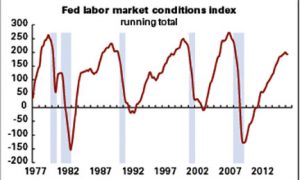In our reports, we have often made the point that the belief that shoppers spend their fuel savings on other sending is largely a myth—overall spending and spending on gas generally move together, and we tend to drive more when gas is cheaper. But just what is the relationship between oil prices and economic growth? Are high prices signs of economic strength or do they portend decline? Conversely, are low prices stimulative, or are they a sign of weakness? How do we separate cause and effect?
New York Fed economists Jan Groen and Patrick Russo have been on the case. The answer is basically—and unsurprisingly—“it’s complicated.” Groen and Russo develop a model, using what they describe as “a large number of financial variables,” to isolate supply and demand influences on the price of Brent crude since 1986. In a June 2015 post, they report that the price declines of the late 1980s and late 1990s were driven by supply-side shocks, namely aggressive expansion of production by OPEC members, notably Saudi Arabia. More recently, they find that the 2001–2001 and 2007–2009 declines were driven by demand shocks resulting from U.S. recessions. But outside these recessions, tighter supplies put upward pressure on prices through 2010. Between 2010 and 2012, prices were driven higher by a combination of rising demand and supply constraints. But since then, expanding supply has driven prices lower—a tendency that was partly counterbalanced at first by rising demand through mid-2014. Since then, demand has weakened while supply has remained plentiful.
And what are the effects of changes in oil prices? They find that price declines resulting from supply shocks have only modestly stimulative effects on GDP and consumption—roughly a +0.10–0.15% kick to both from a one-standard-deviation supply shock in the first quarter or two afterwards that decays in about four quarters. Real nonresidential fixed investment responds more strongly but more slowly, maxing out at about 0.30% three quarters after the shock. Investment takes a little longer to decay, but the effect is all gone in seven or eight quarters. Their model projected that the decline in oil prices of late 2014 and early 2015 would have only a modest stimulative effect during the second half of 2015, and would be mostly dissipated by early 2016. Given recent growth rates, that looks like not a bad forecast.
In a recent post, Groen and Russo updated their work. Their model suggests that the price declines in late 2015 and early 2016 have had and will have little effect this year. Perhaps, then, we all pay too much attention to oil prices.





Oil and the Economy
In our reports, we have often made the point that the belief that shoppers spend their fuel savings on other sending is largely a myth—overall spending and spending on gas generally move together, and we tend to drive more when gas is cheaper. But just what is the relationship between oil prices and economic growth? Are high prices signs of economic strength or do they portend decline? Conversely, are low prices stimulative, or are they a sign of weakness? How do we separate cause and effect?
New York Fed economists Jan Groen and Patrick Russo have been on the case. The answer is basically—and unsurprisingly—“it’s complicated.” Groen and Russo develop a model, using what they describe as “a large number of financial variables,” to isolate supply and demand influences on the price of Brent crude since 1986. In a June 2015 post, they report that the price declines of the late 1980s and late 1990s were driven by supply-side shocks, namely aggressive expansion of production by OPEC members, notably Saudi Arabia. More recently, they find that the 2001–2001 and 2007–2009 declines were driven by demand shocks resulting from U.S. recessions. But outside these recessions, tighter supplies put upward pressure on prices through 2010. Between 2010 and 2012, prices were driven higher by a combination of rising demand and supply constraints. But since then, expanding supply has driven prices lower—a tendency that was partly counterbalanced at first by rising demand through mid-2014. Since then, demand has weakened while supply has remained plentiful.
And what are the effects of changes in oil prices? They find that price declines resulting from supply shocks have only modestly stimulative effects on GDP and consumption—roughly a +0.10–0.15% kick to both from a one-standard-deviation supply shock in the first quarter or two afterwards that decays in about four quarters. Real nonresidential fixed investment responds more strongly but more slowly, maxing out at about 0.30% three quarters after the shock. Investment takes a little longer to decay, but the effect is all gone in seven or eight quarters. Their model projected that the decline in oil prices of late 2014 and early 2015 would have only a modest stimulative effect during the second half of 2015, and would be mostly dissipated by early 2016. Given recent growth rates, that looks like not a bad forecast.
In a recent post, Groen and Russo updated their work. Their model suggests that the price declines in late 2015 and early 2016 have had and will have little effect this year. Perhaps, then, we all pay too much attention to oil prices.